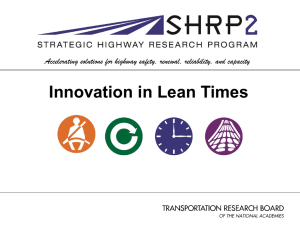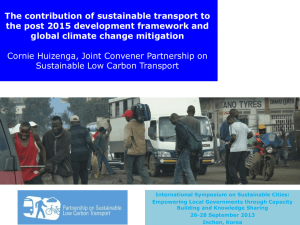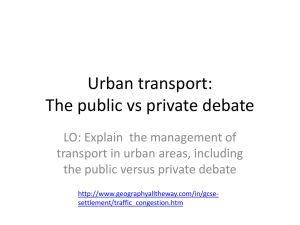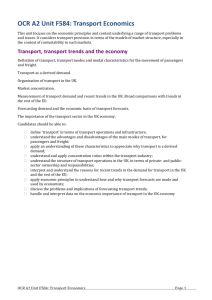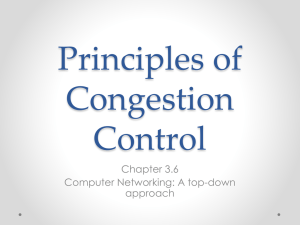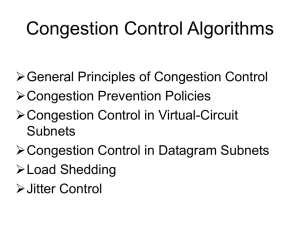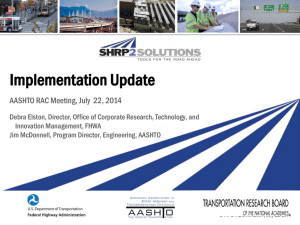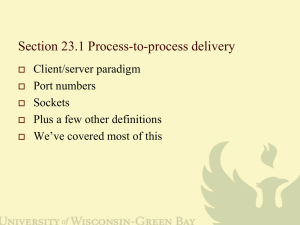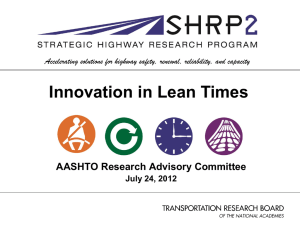SHRP2_L11-TRB-Poster-January-6
advertisement
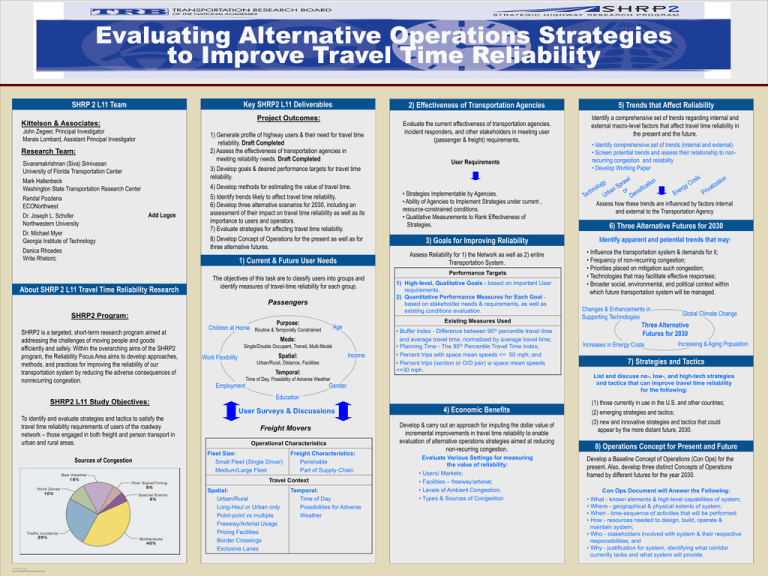
Evaluating Alternative Operations Strategies to Improve Travel Time Reliability Key SHRP2 L11 Deliverables SHRP 2 L11 Team Project Outcomes: Kittelson & Associates: John Zegeer, Principal Investigator Marais Lombard, Assistant Principal Investigator Research Team: Sivaramakrishnan (Siva) Srinivasan University of Florida Transportation Center Mark Hallenbeck Washington State Transportation Research Center Randal Pozdena ECONorthwest Dr. Joseph L. Schofer Northwestern University Dr. Michael Myer Georgia Institute of Technology 2) Effectiveness of Transportation Agencies Add Logos Danica Rhoades Write Rhetoric 1) Generate profile of highway users & their need for travel time reliability. Draft Completed 2) Assess the effectiveness of transportation agencies in meeting reliability needs. Draft Completed 3) Develop goals & desired performance targets for travel time reliability. 4) Develop methods for estimating the value of travel time. 5) Identify trends likely to affect travel time reliability. 6) Develop three alternative scenarios for 2030, including an assessment of their impact on travel time reliability as well as its importance to users and operators. 7) Evaluate strategies for affecting travel time reliability. 8) Develop Concept of Operations for the present as well as for three alternative futures. The objectives of this task are to classify users into groups and identify measures of travel-time reliability for each group. Passengers SHRP2 Program: SHRP2 is a targeted, short-term research program aimed at addressing the challenges of moving people and goods efficiently and safely. Within the overarching aims of the SHRP2 program, the Reliability Focus Area aims to develop approaches, methods, and practices for improving the reliability of our transportation system by reducing the adverse consequences of nonrecurring congestion. SHRP2 L11 Study Objectives: To identify and evaluate strategies and tactics to satisfy the travel time reliability requirements of users of the roadway network – those engaged in both freight and person transport in urban and rural areas. Sources of Congestion Purpose: Mode: Single/Double Occupant, Transit, Multi-Modal Income Spatial: Work Flexibility Urban/Rural, Distance, Facilities Temporal: Employment Performance Targets 1) High-level, Qualitative Goals - based on important User requirements. 2) Quantitative Performance Measures for Each Goal based on stakeholder needs & requirements, as well as existing conditions evaluation. • Buffer Index - Difference between 95th percentile travel time and average travel time, normalized by average travel time; • Planning Time - The 95th Percentile Travel Time Index; • Percent trips with space mean speeds <= 50 mph; and • Percent trips (section or O/D pair) w space mean speeds <=30 mph. Education User Surveys & Discussions Freight Movers Operational Characteristics Fleet Size: Small Fleet (Single Driver) Medium/Large Fleet Freight Characteristics: Perishable Part of Supply-Chain Temporal: Time of Day Possibilities for Adverse Weather Identify a comprehensive set of trends regarding internal and external macro-level factors that affect travel time reliability in the present and the future. • Identify comprehensive set of trends (internal and external) • Screen potential trends and assess their relationship to nonrecurring congestion and reliability • Develop Working Paper Assess how these trends are influenced by factors internal and external to the Transportation Agency 6) Three Alternative Futures for 2030 Identify apparent and potential trends that may: • Influence the transportation system & demands for it; • Frequency of non-recurring congestion; • Priorities placed on mitigation such congestion; • Technologies that may facilitate effective responses; • Broader social, environmental, and political context within which future transportation system will be managed. Changes & Enhancements in Supporting Technologies Global Climate Change Three Alternative Futures for 2030 Increases in Energy Costs Increasing & Aging Population 7) Strategies and Tactics List and discuss no-, low-, and high-tech strategies and tactics that can improve travel time reliability for the following: Gender Spatial: Urban/Rural Long-Haul or Urban only Point-point vs multiple Freeway/Arterial Usage Pricing Facilities Border Crossings Exclusive Lanes www.PosterPresentations.com 3) Goals for Improving Reliability Time of Day, Possibility of Adverse Weather Travel Context TEMPLATE DESIGN © 2008 • Strategies Implementable by Agencies. • Ability of Agencies to Implement Strategies under current , resource-constrained conditions. • Qualitative Measurements to Rank Effectiveness of Strategies. Existing Measures Used Age Children at Home Routine & Temporally Constrained User Requirements Assess Reliability for 1) the Network as well as 2) entire Transportation System. 1) Current & Future User Needs About SHRP 2 L11 Travel Time Reliability Research Evaluate the current effectiveness of transportation agencies, incident responders, and other stakeholders in meeting user (passenger & freight) requirements. 5) Trends that Affect Reliability 4) Economic Benefits Develop & carry out an approach for imputing the dollar value of incremental improvements in travel time reliability to enable evaluation of alternative operations strategies aimed at reducing non-recurring congestion. Evaluate Various Settings for measuring the value of reliability: • Users/ Markets; • Facilities – freeway/arterial; • Levels of Ambient Congestion; • Types & Sources of Congestion (1) those currently in use in the U.S. and other countries; (2) emerging strategies and tactics; (3) new and innovative strategies and tactics that could appear by the more distant future, 2030. 8) Operations Concept for Present and Future Develop a Baseline Concept of Operations (Con Ops) for the present. Also, develop three distinct Concepts of Operations framed by different futures for the year 2030. Con Ops Document will Answer the Following: • What - known elements & high-level capabilities of system; • Where - geographical & physical extents of system; • When - time-sequence of activities that will be performed; • How - resources needed to design, build, operate & maintain system; • Who - stakeholders involved with system & their respective responsibilities; and • Why - justification for system, identifying what corridor currently lacks and what system will provide.
